2000 MERCEDES-BENZ SL600 climate control
[x] Cancel search: climate controlPage 99 of 297
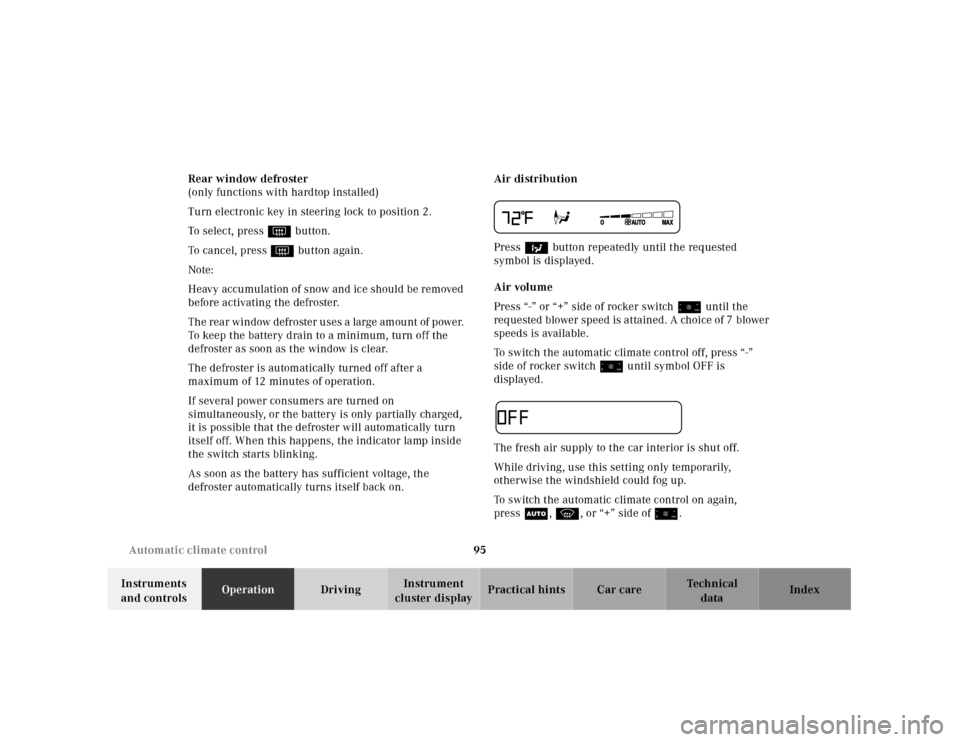
95 Automatic climate control
Technical
data Instruments
and controlsOperationDrivingInstrument
cluster displayPractical hints Car care Index Rear window defroster
(only functions with hardtop installed)
Turn electronic key in steering lock to position 2.
To select, press F button.
To cancel, press F button again.
Note:
H eavy accu mul ation of snow and ic e shoul d be removed
before activating the defroster.
Th e rea r window defroster u ses a large am ou nt of power.
To keep the battery drain to a minimum, turn off the
defroster as soon as the window is clear.
The defroster is automatically turned off after a
maximum of 12 minutes of operation.
If several power consumers are turned on
simultaneously, or the battery is only partially charged,
it is possible that the defroster will automatically turn
itself off. When this happens, the indicator lamp inside
the switch starts blinking.
As soon as the battery has sufficient voltage, the
defroster automatically turns itself back on.Air distribution
Press b button repeatedly until the requested
symbol is displayed.
Air volume
Press “-” or “+” side of rocker switch ï until the
requested blower speed is attained. A choice of 7 blower
speeds is available.
To switch the automatic climate control off, press “-”
side of rocker switch ï until symbol OFF is
displayed.
The fresh air supply to the car interior is shut off.
While driving, use this setting only temporarily,
otherwise the windshield could fog up.
To switch the automatic climate control on again,
pressU, P, or “+” side ofï.
Page 100 of 297
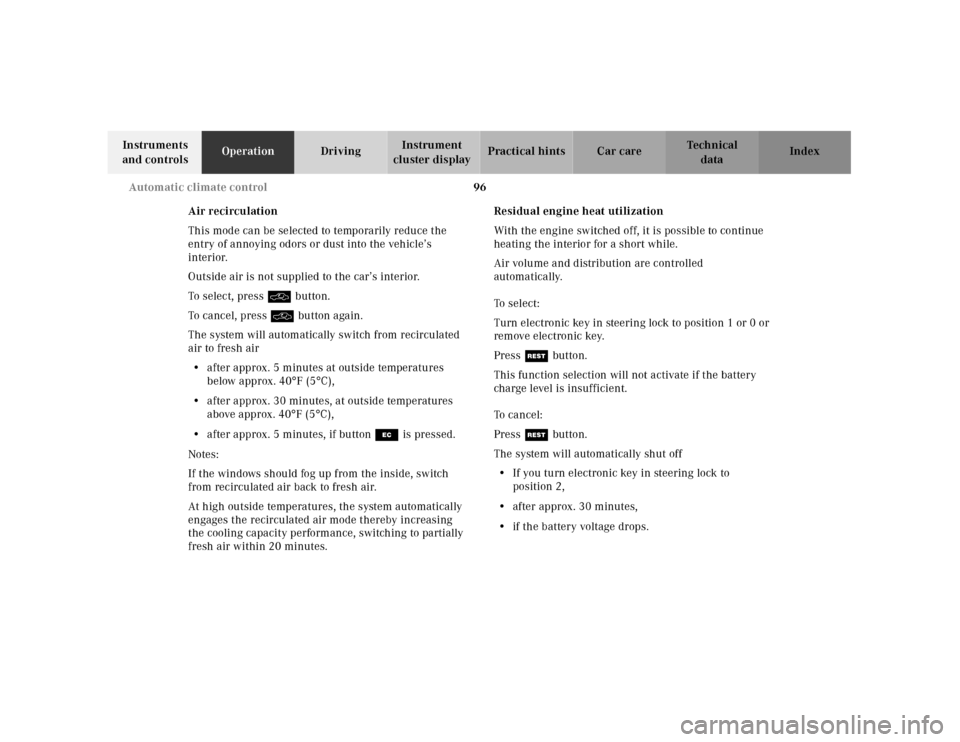
96 Automatic climate control
Technical
data Instruments
and controlsOperationDrivingInstrument
cluster displayPractical hints Car care Index
Air recirculation
This mode can be selected to temporarily reduce the
entry of annoying odors or dust into the vehicle’s
interior.
Outside air is not supplied to the car’s interior.
To select, press O button.
To cancel, press O button again.
The system will automatically switch from recirculated
air to fresh air
• after approx. 5 minutes at outside temperatures
below approx. 40°F (5°C),
• after approx. 30 minutes, at outside temperatures
above approx. 40°F (5°C),
• after approx. 5 minutes, if button S is pressed.
Notes:
If the windows should fog up from the inside, switch
from recirculated air back to fresh air.
At high outside temperatures, the system automatically
engages the recirculated air mode thereby increasing
the cooling capacity performance, switching to partially
fresh air within 20 minutes.Residual engine heat utilization
With the engine switched off, it is possible to continue
heating the interior for a short while.
Air volume and distribution are controlled
automatically.
To select:
Turn electronic key in steering lock to position 1 or 0 or
remove electronic key.
Press T button.
This function selection will not activate if the battery
charge level is insufficient.
To c a n c e l :
Press T button.
The system will automatically shut off
• If you turn electronic key in steering lock to
position 2,
• after approx. 30 minutes,
• if the battery voltage drops.
Page 101 of 297
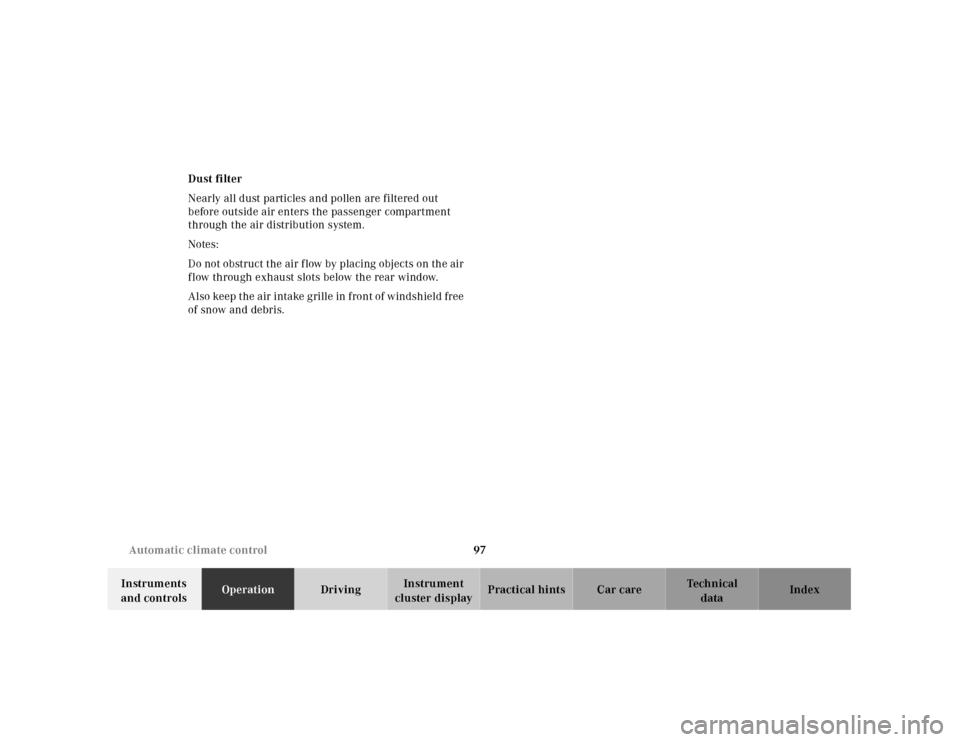
97 Automatic climate control
Technical
data Instruments
and controlsOperationDrivingInstrument
cluster displayPractical hints Car care Index Dust filter
Nearly all dust particles and pollen are filtered out
before outside air enters the passenger compartment
through the air distribution system.
Notes:
D o not obstruct t he air f low by pla cing objects on th e air
f low through exhaust slots below the rear window.
Al so keep t he a ir inta ke g rill e in f ront of w indsh iel d free
of snow and debris.
Page 266 of 297
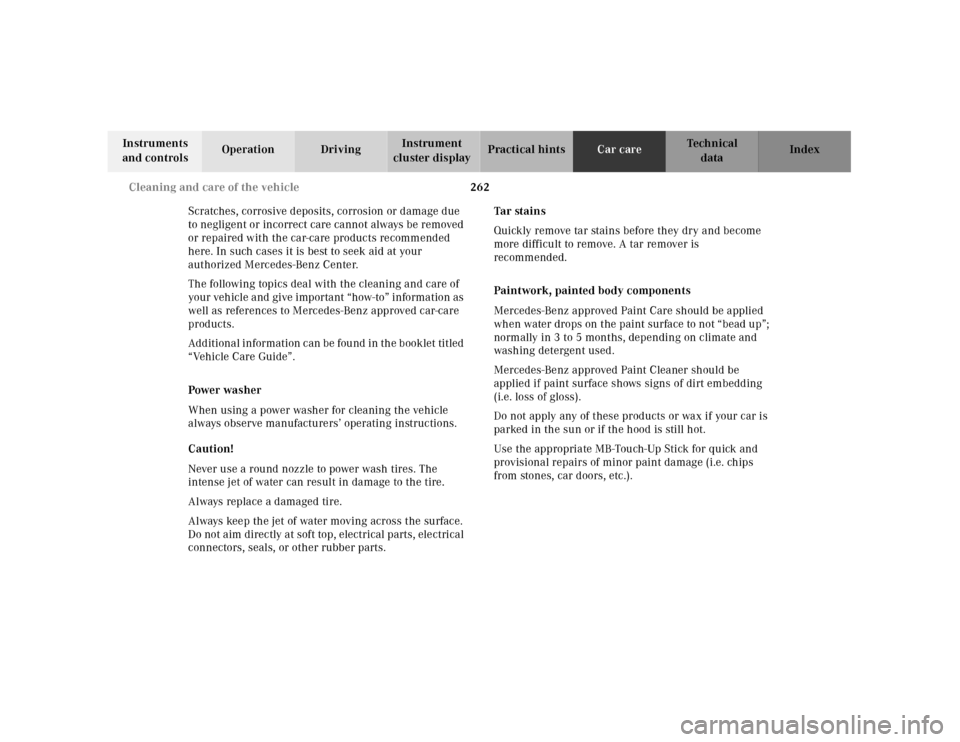
262 Cleaning and care of the vehicle
Technical
data Instruments
and controlsOperation DrivingInstrument
cluster displayPractical hintsCar careIndex
Scratches, corrosive deposits, corrosion or damage due
to negligent or incorrect care cannot always be removed
or repaired with the car-care products recommended
here. In such cases it is best to seek aid at your
authorized Mercedes-Benz Center.
The following topics deal with the cleaning and care of
your veh icl e a nd give importa nt “how-to” informa tion as
well as references to Mercedes-Benz approved car-care
products.
Ad d it i on a l i n f or m a t i on c a n b e f ou nd i n t h e b oo k l e t ti t l e d
“Vehicle Care Guide”.
Power washer
When using a power washer for cleaning the vehicle
always observe manufacturers’ operating instructions.
Caution!
Never use a round nozzle to power wash tires. The
intense jet of water can result in damage to the tire.
Always replace a damaged tire.
Always keep the jet of water moving across the surface.
Do not aim directly at soft top, electrical parts, electrical
connectors, seals, or other rubber parts.Tar stains
Quickly remove tar stains before they dry and become
more difficult to remove. A tar remover is
recommended.
Paintwork, painted body components
Mercedes-Benz approved Paint Care should be applied
when water drops on the paint surface to not “bead up”;
normally in 3 to 5 months, depending on climate and
washing detergent used.
Mercedes-Benz approved Paint Cleaner should be
applied if paint surface shows signs of dirt embedding
(i.e. loss of gloss).
Do not apply any of these products or wax if your car is
parked in the sun or if the hood is still hot.
Use the appropriate MB-Touch-Up Stick for quick and
provisional repairs of minor paint damage (i.e. chips
from stones, car doors, etc.).
Page 286 of 297
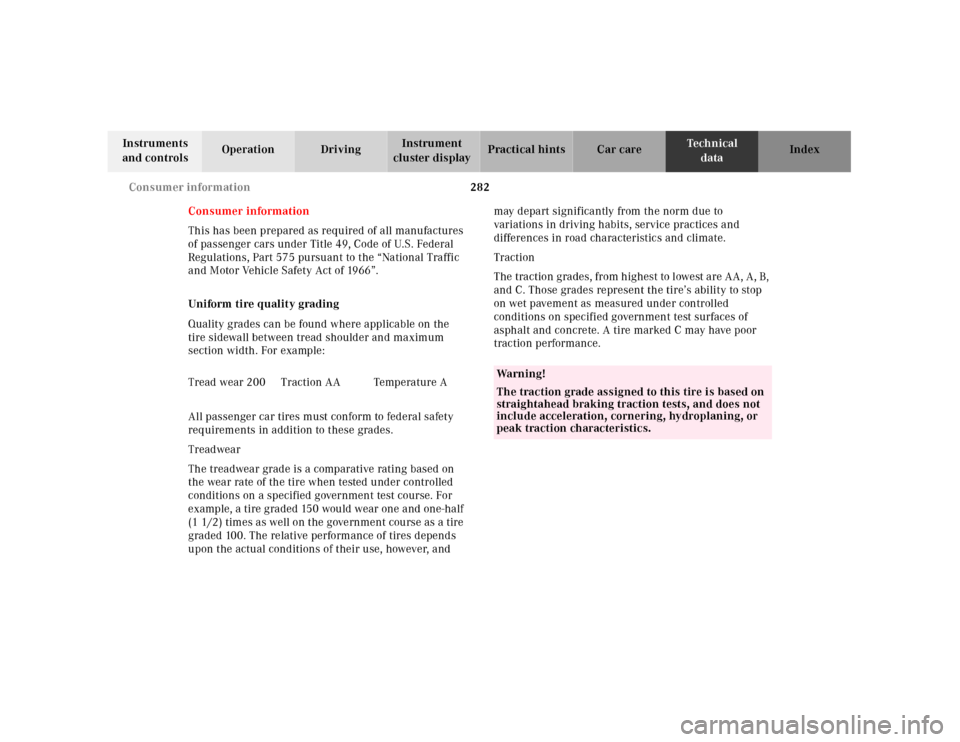
282 Consumer information
Technical
data Instruments
and controlsOperation DrivingInstrument
cluster displayPractical hints Car care Index
Consumer information
This has been prepared as required of all manufactures
of passenger cars under Title 49, Code of U.S. Federal
Regulations, Part 575 pursuant to the “National Traffic
and Motor Vehicle Safety Act of 1966”.
Uniform tire quality grading
Quality grades can be found where applicable on the
tire sidewall between tread shoulder and maximum
section width. For example:
All passenger car tires must conform to federal safety
requirements in addition to these grades.
Treadwear
The treadwear grade is a comparative rating based on
the wear rate of the tire when tested under controlled
conditions on a specified government test course. For
example, a tire graded 150 would wear one and one-half
(1 1/2) times as well on the government course as a tire
graded 100. The relative performance of tires depends
upon the actual conditions of their use, however, and may depart significantly from the norm due to
variations in driving habits, service practices and
differences in road characteristics and climate.
Traction
The traction grades, from highest to lowest are AA, A, B,
and C. Those grades represent the tire’s ability to stop
on wet pavement as measured under controlled
conditions on specified government test surfaces of
asphalt and concrete. A tire marked C may have poor
traction performance.
Tread wear 200 Traction AA Temperature A
Wa r n i n g !
The traction grade assigned to this tire is based on
straightahead braking traction tests, and does not
include acceleration, cornering, hydroplaning, or
peak traction characteristics.
Page 289 of 297
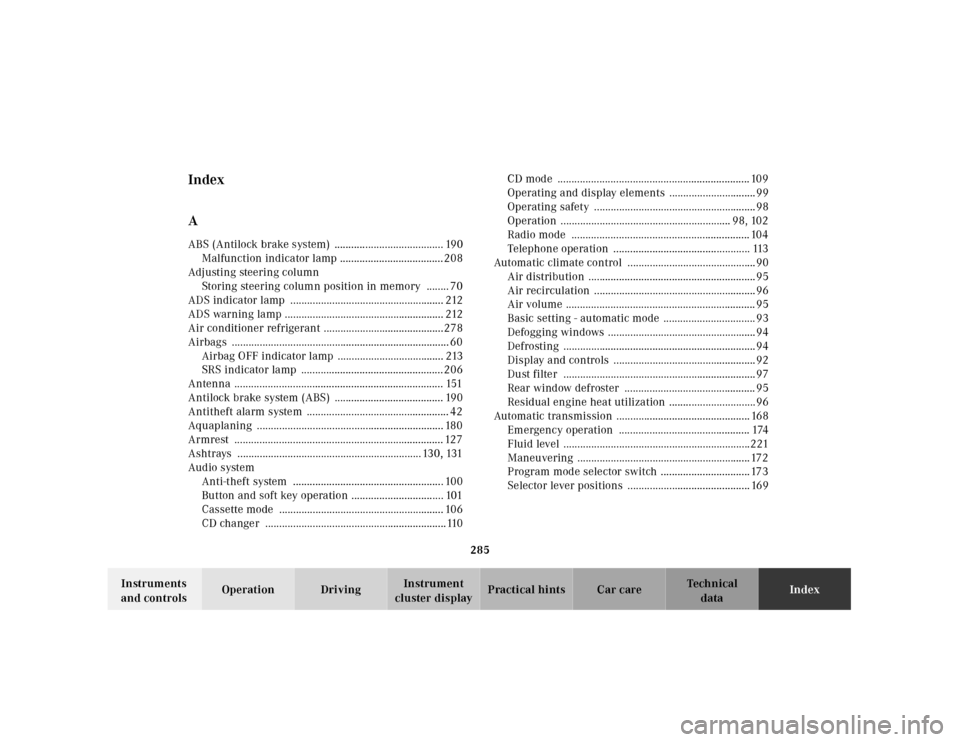
285
Technical
data Instruments
and controlsOperation DrivingInstrument
cluster displayPractical hints Car careIndex
Index
AABS (Antilock brake system) ....................................... 190
Malfunction indicator lamp .....................................208
Adj usting steering c ol umn
Storing steering column position in memory ........ 70
ADS indicator lamp ....................................................... 212
ADS warning lamp ......................................................... 212
Air conditioner refrigerant ...........................................278
Airbags .............................................................................. 60
Airbag OFF indicator lamp ...................................... 213
SRS indicator lamp ...................................................206
Antenna ........................................................................... 151
Antilock brake system (ABS) ....................................... 190
Antitheft alarm system ................................................... 42
Aquaplaning ................................................................... 180
Armrest ........................................................................... 127
Ashtrays .................................................................. 130, 131
Audio system
Anti-theft system ...................................................... 100
Button and soft key operation ................................. 101
Cassette mode ........................................................... 106
CD changer .................................................................110CD mode ..................................................................... 109
Operating and display elements ...............................99
Operating safety ..........................................................98
Operation ............................................................. 98, 102
Radio mode ................................................................ 104
Telephone operation ................................................. 113
Automatic climate control ..............................................90
Air distribution ............................................................95
Air recirculation ..........................................................96
Air volume .................................................................... 95
Basic setting - automatic mode ................................. 93
Defogging windows .....................................................94
Defrosting .....................................................................94
Display and controls ...................................................92
Dust filter .....................................................................97
Rear window defroster ............................................... 95
Residual engine heat utilization ...............................96
Automatic transmission ................................................ 168
Emergency operation ............................................... 174
Fluid level ...................................................................221
Maneuvering ..............................................................172
Program mode selector switch ................................173
Selector lever positions ............................................ 169